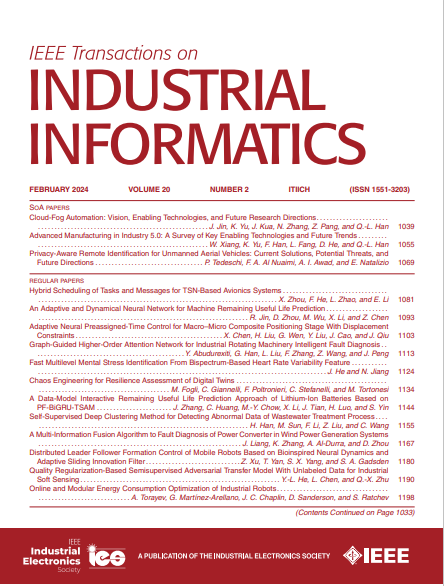ADSTAN:无监督跨域电池SOH估计的对抗性动态时空注意网络
IF 9.9
1区 计算机科学
Q1 AUTOMATION & CONTROL SYSTEMS
引用次数: 0
摘要
健康状态(SOH)估计对于电池健康监测至关重要,特别是在数据可变性和域转移带来重大挑战的跨域场景中。为了解决这些问题,本研究提出了对抗动态时空注意网络(ADSTAN),该网络集成了用于空间特征提取的图注意网络、用于时间依赖性建模的门控循环单元和用于无监督域自适应的基于梯度反转层的域对齐模块。ADSTAN将电池健康数据表示为动态图形,每个周期作为一个节点,有效地捕获时空依赖关系,并动态地对齐源域和目标域之间的特征分布。在包括CALCE和NASA电池数据集在内的跨域数据集上的实验证明了该模型的有效性。利用10个周期的数据预测5层、10层和15层的SOH, ADSTAN的RMSE值分别为2.49%、2.61%和2.94%。烧蚀实验验证了该模型的设计,突出了其空间、时间和对准模块的优越性。这些结果强调了ADSTAN的稳健性能及其在不同跨域设置中准确和通用的SOH估计的适用性。本文章由计算机程序翻译,如有差异,请以英文原文为准。
ADSTAN: Adversarial Dynamic Spatiotemporal Attention Networks for Unsupervised Cross-Domain Battery SOH Estimation
State of health (SOH) estimation is essential for battery health monitoring, particularly in cross-domain scenarios where data variability and domain shifts present significant challenges. To address these issues, this study proposes the adversarial dynamic spatiotemporal attention network (ADSTAN), which integrates a graph attention network for spatial feature extraction, a gated recurrent unit for temporal dependency modeling, and a gradient reversal layer-based domain alignment module for unsupervised domain adaptation. Representing battery health data as dynamic graphs, with each cycle serving as a node, ADSTAN effectively captures spatiotemporal dependencies and dynamically aligns feature distributions between source and target domains. Experiments on cross-domain datasets, including the CALCE and NASA battery datasets, demonstrate the model’s effectiveness. Using data from 10 cycles to predict SOH for 5, 10, and 15 horizons, ADSTAN achieved RMSE values of 2.49%, 2.61%, and 2.94%, respectively. Ablation experiments validated the model’s design, highlighting the superiority of its spatial, temporal, and alignment modules. These results underscore ADSTAN’s robust performance and its suitability for accurate and generalizable SOH estimation in diverse cross-domain settings.
求助全文
通过发布文献求助,成功后即可免费获取论文全文。
去求助
来源期刊

IEEE Transactions on Industrial Informatics
工程技术-工程:工业
CiteScore
24.10
自引率
8.90%
发文量
1202
审稿时长
5.1 months
期刊介绍:
The IEEE Transactions on Industrial Informatics is a multidisciplinary journal dedicated to publishing technical papers that connect theory with practical applications of informatics in industrial settings. It focuses on the utilization of information in intelligent, distributed, and agile industrial automation and control systems. The scope includes topics such as knowledge-based and AI-enhanced automation, intelligent computer control systems, flexible and collaborative manufacturing, industrial informatics in software-defined vehicles and robotics, computer vision, industrial cyber-physical and industrial IoT systems, real-time and networked embedded systems, security in industrial processes, industrial communications, systems interoperability, and human-machine interaction.
 求助内容:
求助内容: 应助结果提醒方式:
应助结果提醒方式:


